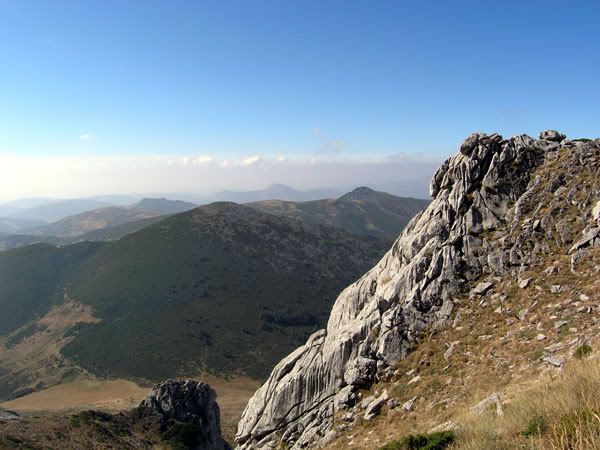Yes, it truly is a hard life. No sooner am I back from one trip to sunny Iberia, it seems, than I get sent off on another. This time I was out in the Cantabrians in Northern Spain, to get 2nd going on 3rd years started on their independent mapping. More specifically, we were letting them loose around the towns of Villamanin and La Pola de Gordon, just north of Leon.
Back in my day (which doesn't feel that long ago, until I actually reflect on it and realise it was the end of the last millenium; several of the students are conspiring to make me feel old by having their 20th birthdays whilst out there) I got no such help, but given the complexity of the area, I don't begrudge the students some assistance. The rocks consist of a sequence of sandstones, limestones and shales, ranging in age from the Middle Cambrian (~550 million years ago) to the latest Carboniferous (~280 million years ago – here’s a timescale for your convenience), which were deformed mainly in the Variscan Orogeny (the uppermost units were actually deposited during or after this mountain building event). This has resulted in some quite complex geology. The picture below looks south from one of the highest points in the region:
The high ridges you see extending into the distance are pretty much made up of the same rock unit – the massive Barrios quartz sandstone. The fact that it keeps on appearing indicates the presence of many thrust faults which have caused the same sequence of rock units to repeat itself a number of times. Further to the south ridges of younger limestone also appear repeatedly. This photo is in fact taken across a massive fault: I’m standing on a Carboniferous limestone which is right next to the much older (Ordovician) Barrios, with most of the intervening units missing.
An additional wrinkle is illustrated by a second photo, which shows some very well preserved ripple marks preserved on the steeply-dipping bedding surface of a sandstone. You could find something similar on any beach today – but these ripples formed back before tetrapods were a twinkle in some ancient lobefins’ eye (if that makes no sense, have a read here or here). 
But what’s puzzling here is that you’d expect to find these structures on the top surface of a bedding plane, and here they’re on the bottom. The deformation in this area has been so extreme that this bed has been overturned. In fact, in most places where sedimentary structures or burrows are found in this area, they indicate that the units are upside down. That’s some extreme deformation for you.
All of this gives our students plenty to mull over, and is why this region is a popular mapping area for many universities – in the last fortnight we met people from Imperial, Oxford and Dublin also wandering through the area. But given that the area is so sliced up by faults, it seems only fair to make sure the students know what the actual stratigraphic sequence is supposed to be (so they can spot missing and repeated sequences). We did this in a couple of induction days with the whole group, before some more individual tuition: pairs of students are mapping different, and separate, areas (for safety – they have to make their own observations and interpretations), and I went around with each of my groups individually around their area to make sure they had their eye in on the different units, and to check that they understood the process of mapping. It seemed that my efforts to provide some general clues on how to approach things were not entirely in vain - even before we left I saw some field slips with boundaries being drawn on, and many of the students I am supervising at least seemed to be asking the right sort of questions, even if their attempts to answer them were sometimes a little off-base. Of course, this year's lot may just be better than last year's, and it's nothing to do with me whatsoever, but I'll cling to the illusion that I was helping to make a difference. Of course, the real test comes when I see the finished results at the end of the summer...
17 July, 2006
Back from Spain...again
Subscribe to:
Post Comments (Atom)




No comments:
Post a Comment